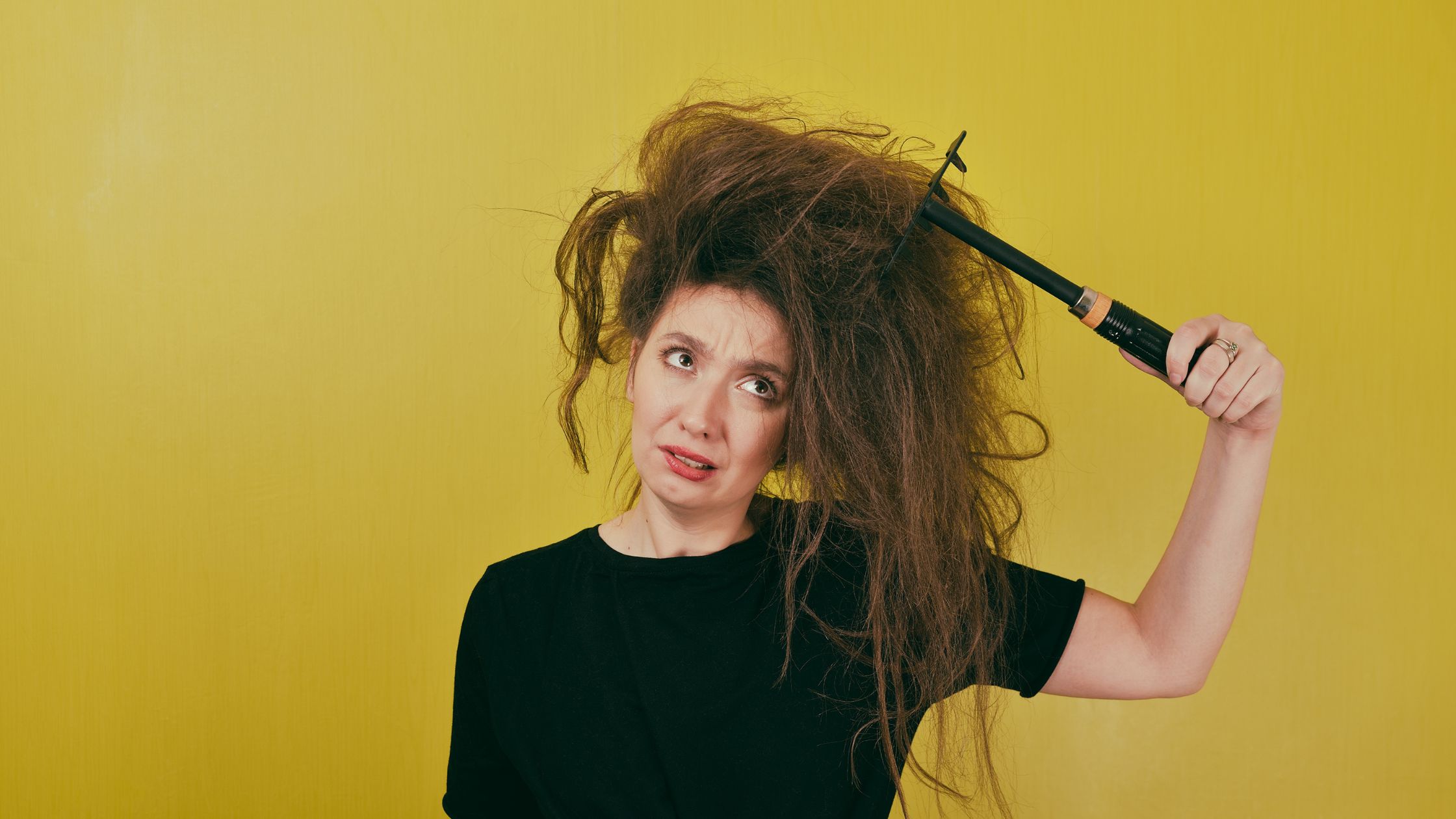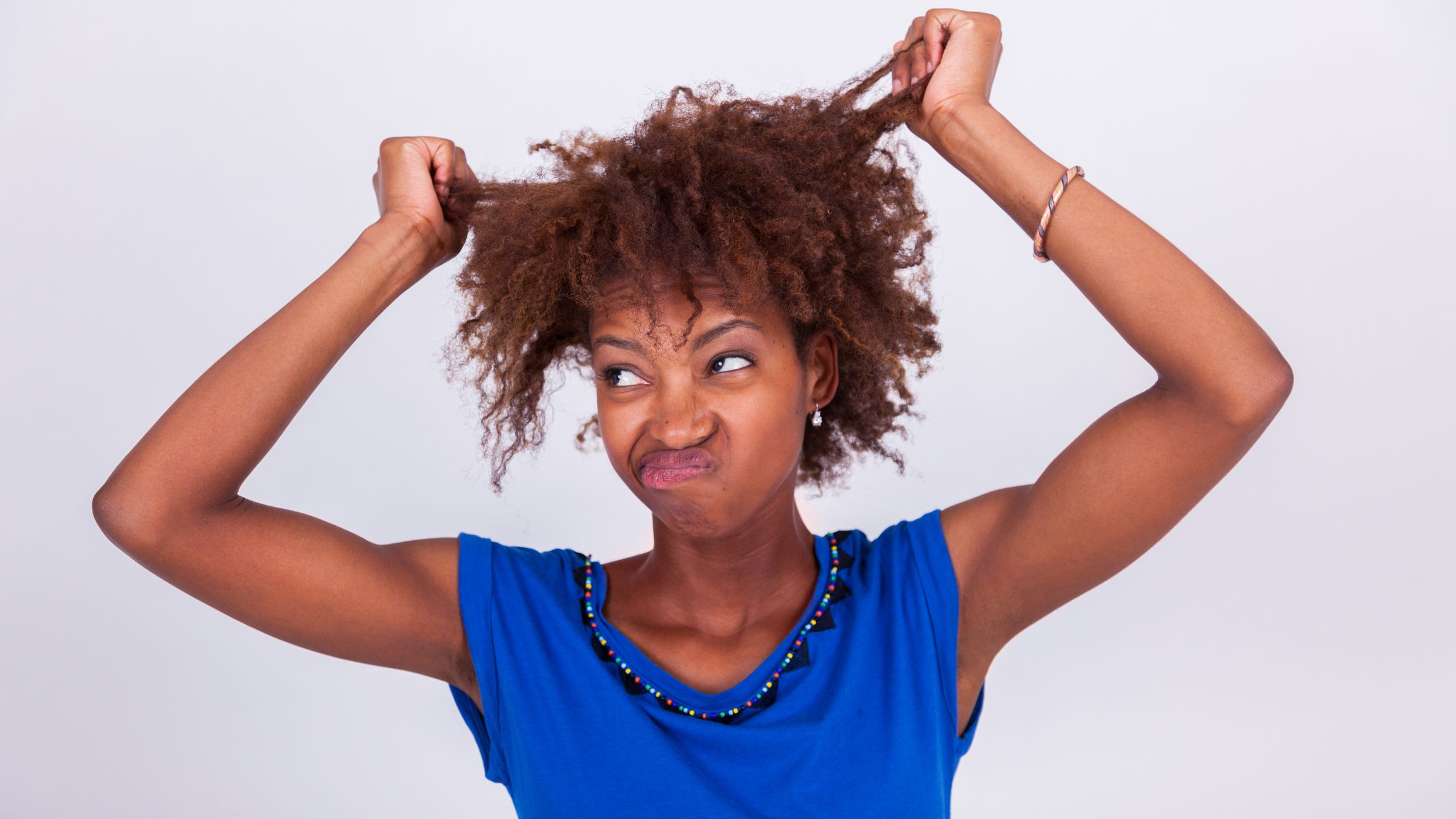
Frizz is a common hair woe that can turn even the best hair days into a struggle. Frizz can occur in any hair type, but it is more common in those with curly or wavy hair. But understanding why hair gets frizzy and how to combat it can transform your tresses from wild to wonderful. In this comprehensive guide, we delve into the causes of frizz, explore effective solutions, and provide expert tips to help you achieve smooth, shiny, and manageable hair.
5 Common causes of frizzy hair
Frizz occurs when hair strands become unruly and lack uniformity. This can happen for several reasons:
- Humidity: The most common reason behind frizz is humidity. When the air is moist, it penetrates the hair shaft, causing the hair to swell and the cuticle (the outermost layer of the hair) to lift. This results in a rough surface that reflects light unevenly, giving the appearance of frizz.
- Hair Damage: Damaged hair is more prone to frizz. Heat styling, chemical treatments, and excessive brushing can all contribute to the weakening of the hair cuticle, making it more susceptible to frizz.
- Dryness: Hair that lacks moisture will seek it from the environment, leading to frizz. This is why maintaining hydration is crucial for smooth hair.
- Hair Texture: Naturally curly and wavy hair types are more prone to frizz because their structure makes it difficult for natural oils to travel from the scalp to the ends, leading to dryness and frizz.
- Improper Hair Care: Using the wrong hair care products or techniques can exacerbate frizz. Harsh shampoos, rough towel drying, and skipping conditioner can all contribute to frizz.
How Do I Fix Frizzy Hair?
Understanding the root causes of frizz is the first step towards managing it. Here are effective strategies to keep your hair smooth and frizz-free:
1- Hydration is Key
- Use a Moisturizing Shampoo and Conditioner: Look for products specifically formulated to hydrate and nourish your hair. Ingredients like glycerin, shea butter, and natural oils are excellent for providing moisture and taming frizz.
- Deep Conditioning Treatments: Incorporate a deep conditioning treatment into your hair care routine once a week. These treatments penetrate the hair shaft to provide intensive moisture and repair.
- Leave-In Conditioners and Serums: Leave-in conditioners and anti-frizz serums can provide an extra layer of protection against humidity. Apply them to damp hair before styling.
Read More- 5 Best Ingredients to Moisturize Your Hair
2- Gentle Handling
- Avoid Heat Styling: Excessive use of heat styling tools can damage the hair cuticle and lead to frizz. Try to limit the use of blow dryers, flat irons, and curling irons. When you do use them, always apply a heat protectant spray.
- Dry Hair Gently: Instead of vigorously towel-drying your hair, blot it gently with a microfiber towel or a soft cotton t-shirt. This reduces friction and prevents the cuticle from lifting.
- Brush Carefully: Use a wide-tooth comb or a brush designed for wet hair to detangle. Start from the end and work your way up to minimize breakage and frizz.
3- Protect from Humidity
- Anti-Humidity Sprays: These products create a barrier that prevents moisture from penetrating the hair shaft. Use them as the final step in your styling routine.
- Silk Pillowcases: Swap your cotton pillowcase for a silk one. Silk causes less friction and helps maintain the hair’s natural oils, reducing frizz overnight.
4- Embrace Natural Oils
- Argan Oil: This is known as liquid gold because its rich in fatty acids and vitamin E, which help tame frizz and add shine. Apply a few drops to the ends of your hair to keep them smooth.
- Coconut Oil: This versatile oil can be used as a pre-wash treatment or a leave-in conditioner. It penetrates the hair shaft to provide deep moisture and reduce frizz.
Best Hair Care Practices for Frizz-Free Hair
Consistency is crucial when it comes to managing frizz. Adopt these hair care practices for long-term results:
1- Regular Trims
Split ends and damaged hair are more prone to frizz. Regular trims every 6-8 weeks help maintain the health of your hair and prevent frizz from spreading.
2- Avoid Harsh Chemicals
Chemical treatments like coloring, perming, and relaxing can weaken the hair cuticle and lead to frizz. If you must color your hair, opt for ammonia-free dyes and always follow up with deep conditioning treatments.
3- Opt for Sulfate-Free Products
Sulfates can strip your hair of its natural oils, leading to dryness and frizz. Choose a sulfate-free shampoo and conditioner to maintain your hair’s moisture balance
4- Use a Humidifier
If you live in a dry climate, consider using a humidifier in your home. This adds moisture to the air and helps keep your hair hydrated.
Expert Tips for Specific Hair Types

Different hair types require tailored approaches to manage frizz effectively. Here’s how to handle frizz based on your hair type:
1- Curly Hair
Curly hair is the most susceptible to frizz due to its structure. Here’s how to keep your curls defined and frizz-free:
- Co-Washing: Instead of shampooing, try co-washing (washing with conditioner) to retain moisture.
- Diffuse When Drying: Use a diffuser attachment on your blow dryer to dry your curls gently. This minimizes frizz and helps maintain curl definition.
- Scrunch with Gel: Apply a curl-defining gel to wet hair and scrunch upwards. This technique helps define curls and control frizz.
2- Wavy Hair
Wavy hair can be tricky because it’s prone to both oiliness at the roots and dryness at the ends. Here’s how to strike the perfect balance:
- Lightweight Products: Use lightweight, hydrating products that won’t weigh down your waves.
- Plop Your Hair: After washing, use a t-shirt to ‘plop’ your hair, encouraging waves to form while reducing frizz.
- Salt Sprays: A sea salt spray can enhance your natural waves and add texture without making your hair frizzy.
3- Straight Hair
Straight hair may not frizz as much as curly or wavy hair, but it can still become unruly. Here’s how to keep it smooth:
- Serum for Shine: Use a shine serum to keep your hair sleek and frizz-free.
- Flat Iron with Care: If you use a flat iron, ensure it’s set to the appropriate temperature for your hair type, and always use a heat protectant.
- Anti-Frizz Sheets: Carry anti-frizz sheets with you to tame flyaways throughout the day.
Home Remedies for Frizzy Hair
For those who prefer natural solutions, here are some DIY remedies to control frizz:
1- Avocado Mask
Mash one ripe avocado and mix it with a tablespoon of olive oil. Apply to your hair and leave it on for 30 minutes before rinsing. Avocado is rich in vitamins and oils that nourish and smooth the hair.
2- Honey and Yogurt
Mix two tablespoons of honey with half a cup of yogurt. Apply the mixture to your hair and leave it on for 20 minutes. Honey is a natural humectant that attracts moisture, while yogurt provides protein to strengthen the hair.
3- Apple Cider Vinegar Rinse
Dilute apple cider vinegar with water (one part vinegar to two parts water) and use it as a final rinse after shampooing. This helps balance the scalp’s pH and smoothens the hair cuticle.
Conclusion
Frizz may be a common hair concern, but it doesn’t have to be a permanent one. By understanding the causes and adopting a consistent hair care routine tailored to your specific needs, you can achieve smooth, shiny, and frizz-free hair. Remember, the key to taming frizz lies in hydration, gentle handling, and using the right products. Embrace these strategies and enjoy gorgeous, manageable hair every day.
